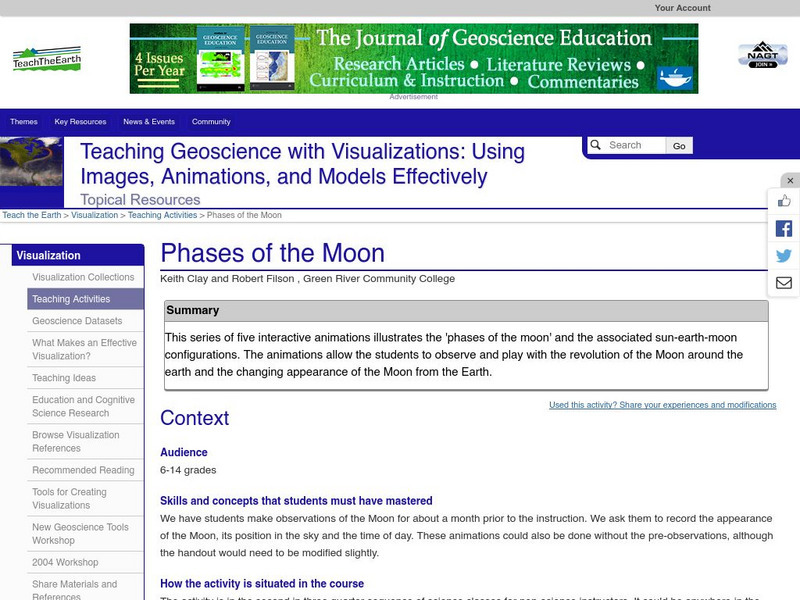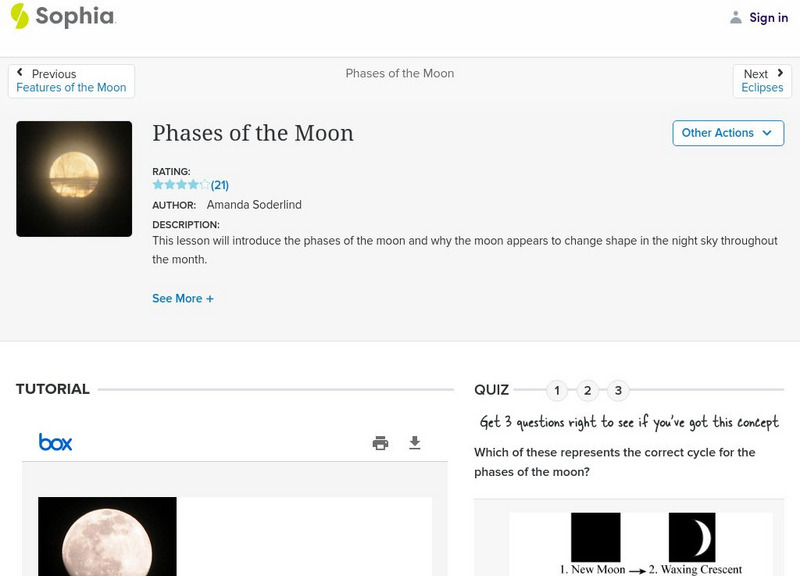Hi, what do you want to do?
Curated OER
How Do Weather Conditions and Lunar Cycles Affect Fishing Success?
Students use weather measuring devices to record and study weather conditions at different locations, during different times. They attempt to draw conclusions about the relationship between weather conditions, lunar cycle and fishing...
Curated OER
Galileo Galilei Questions for Study
In this online interactive philosophy worksheet, students respond to 10 short answer and essay questions about Galileo's contributions to science.
Curated OER
Fourth Grade Social Studies
In this social studies worksheet, 4th graders answer multiple choice questions about wars, congress, colonies, and more. Students complete 25 questions.
Curated OER
Season's Greetings
Students explore Earth's seasons using an interactive website. In this earth science instructional activity, students watch video segments and explain Earth's seasonal milestones. They discuss the factors that causes seasonal changes.
Curated OER
Let the North Star Tell You Where You Are
Students participate in activities in which they find the Big Dipper and locate the North Star in the night sky, examine the relationship between the angle to Polaris and latitude, and determine latitude by using an astrolabe.
Curated OER
Pattern Detectives
Students discover patterns in language, math and science. They experience patterns by hearing stories, and becoming pattern detectives.
Curated OER
Vietnam Trade Pact
Young scholars explore world trade issues. In this economics lesson, students read "Opening Doors to Vietnam," and discuss the trade negotiations between Vietnam and the Untied States. Young scholars conduct further research on the topic...
Curated OER
English Vocabulary Skills: AWL Sublist 4 - Exercise 1b
In this online interactive English vocabulary skills worksheet, students answer 10 matching questions which require them to fill in the blanks in 10 sentences. Students may submit their answers to be scored.
Curated OER
English Vocabulary Skills: AWL Sublist 8 - Exercise 5 B
In this online interactive English vocabulary skills worksheet, students answer 10 matching questions which require them to fill in the blanks in 10 sentences. Students may submit their answers to be scored.
Curated OER
Our Sky Clock
Students explore space science by completing a worksheet in class. In this astronomy lesson, students discuss and identify star patterns in the night sky and relate these patterns to the approximate time they appear. Students complete an...
Curated OER
Collecting Electromagnetic Radiation
Students using different experiments and activities explore electromagnetic radiation and the effect on the Earth.
Curated OER
Sunrise/Sunset
Students apply data from a weather-related website to predict patterns in the sunrise and sunset.
Curated OER
Arranging the Elements
Learners describe how elements are arranged in the periodic table. They compare metals, nonmetals, and metalloids based on their properties and on their location in the periodic table. Finally, students identify and describe the...
Curated OER
Sky Watching
Students examine telescopes and understand how they have helped us better understand the sky. In this astronomy lesson students complete a worksheet and a lab activity.
PBS
Pbs Learning Media: Phases of the Moon
When we look up at the night sky, why do we see the Moon's appearance changing over time from a full sphere to a crescent to nothing at all? Find the answers in this interactive resource adapted from the National Air and Space Museum.
Cornell University
Cornell University: Astronomy: The Phases of the Moon
This site from Cornell University provides great information on the different phases of the moon. As the Moon moves in its orbit around the Sun, our view of the side illuminated by the Sun changes. Furthermore, the rising and setting...
Science Education Resource Center at Carleton College
Serc: Phases of the Moon
An interactive activity where students observe the different phases of the moon. Activity is part of a lesson that includes background information, instructions, and quiz.
Sophia Learning
Sophia: Phases of the Moon
This lesson will introduce the phases of the moon and why the moon appears to change shape in the night sky throughout the month.
ArtsNow
Arts Now Learning: Phases of the Moon [Pdf]
In this lesson, 4th graders use their bodies to model the day/night cycles of the Sun and Earth. Next, they discuss the moon's role in the solar system and explore the eight phases of the moon by acting out a story. Finally, a song...
Michigan Reach Out
Reach Out michigan.org: Phases of the Moon
This site explains the phases of the moon and an easy way to remember waxing and waning. Students have to explain a given phase to their classmates with a model.
Woodlands Junior School
Woodlands Junior School: The Phases of the Moon
This resource provides information about the lunar phases.
NASA
Nasa Star Child: What Are the Phases of the Moon?
This page provides basic information about the causes of the phases of the Moon. A good diagram shows the lit portion of the Moon as seen from Earth through one complete Lunar cycle.
Alabama Learning Exchange
Alex: Phases of the Moon
This instructional activity will familiarize students with the phases of the moon. It can be taught in a unit dealing with the solar system. It involves all learning types-kinesthetic, auditory, tactile, and visual.
Other popular searches
- Draw Phases of Moon
- The Phases of the Moon
- Phases of Moon Inquiry
- The Phases of Moon
- Science Phases of the Moon
- 4 Phases of Moon
- Science Phases of Moon
- Phases of Moon Worksheet
- Technology Phases of Moon
- 8 Phases of the Moon
- Space Phases of Moon
- Phases of the Moon Journal


























